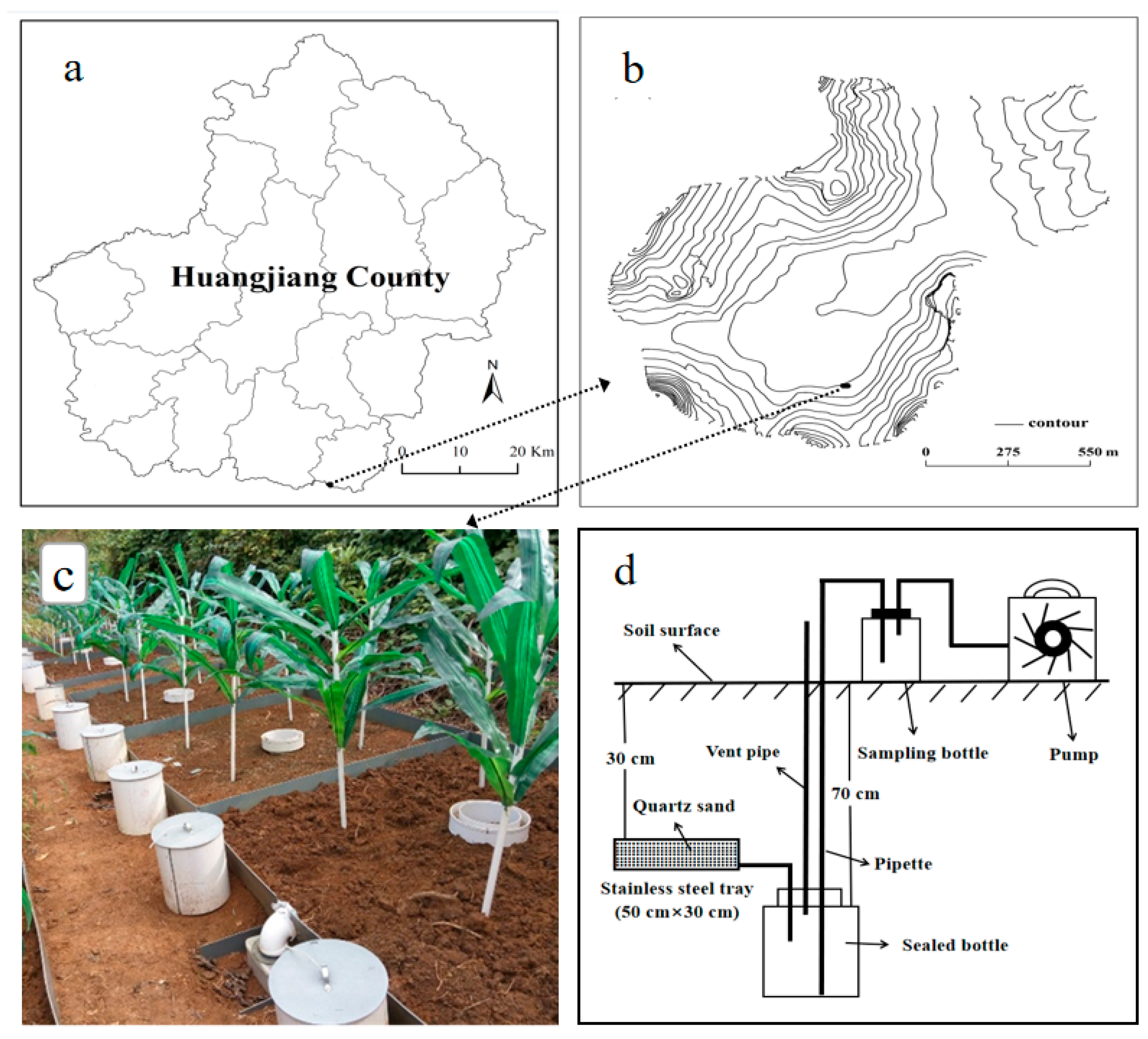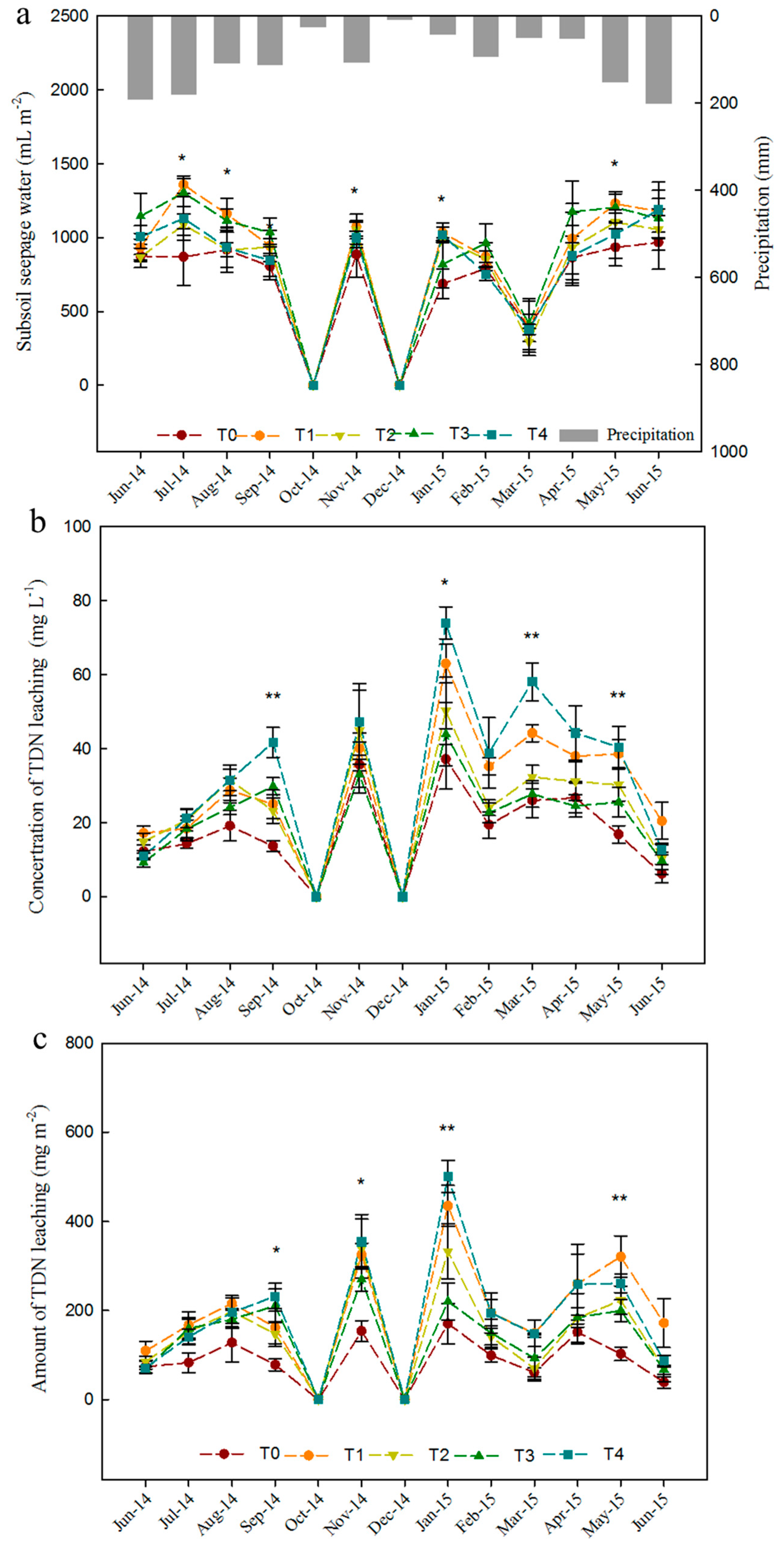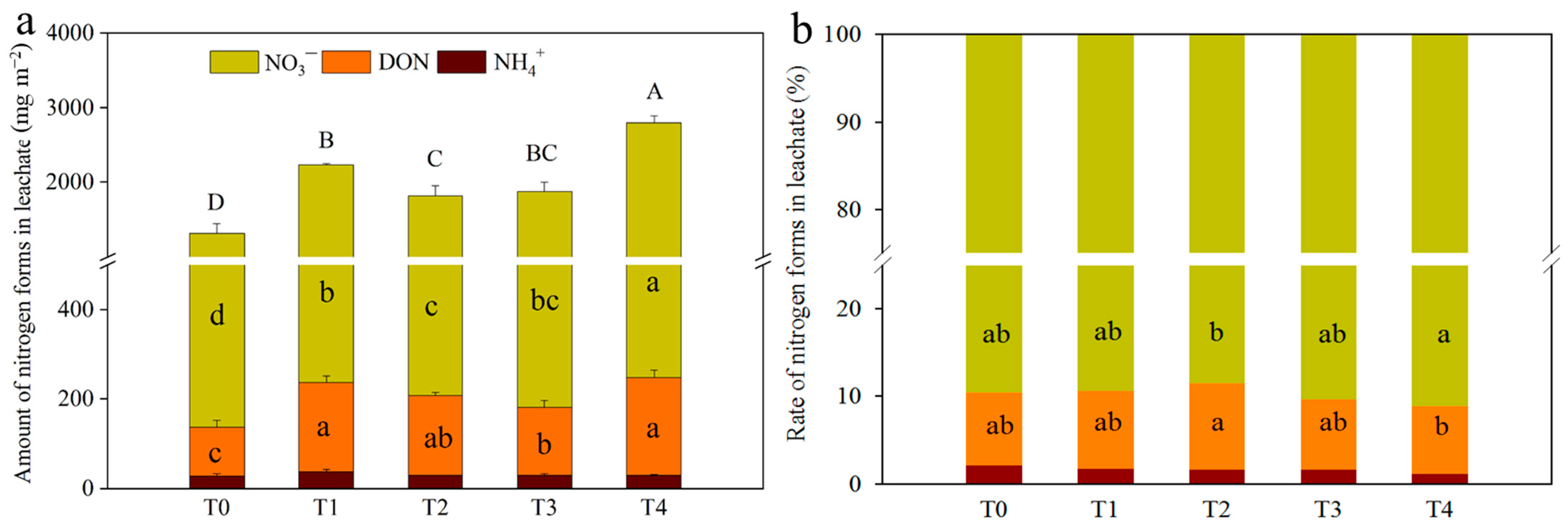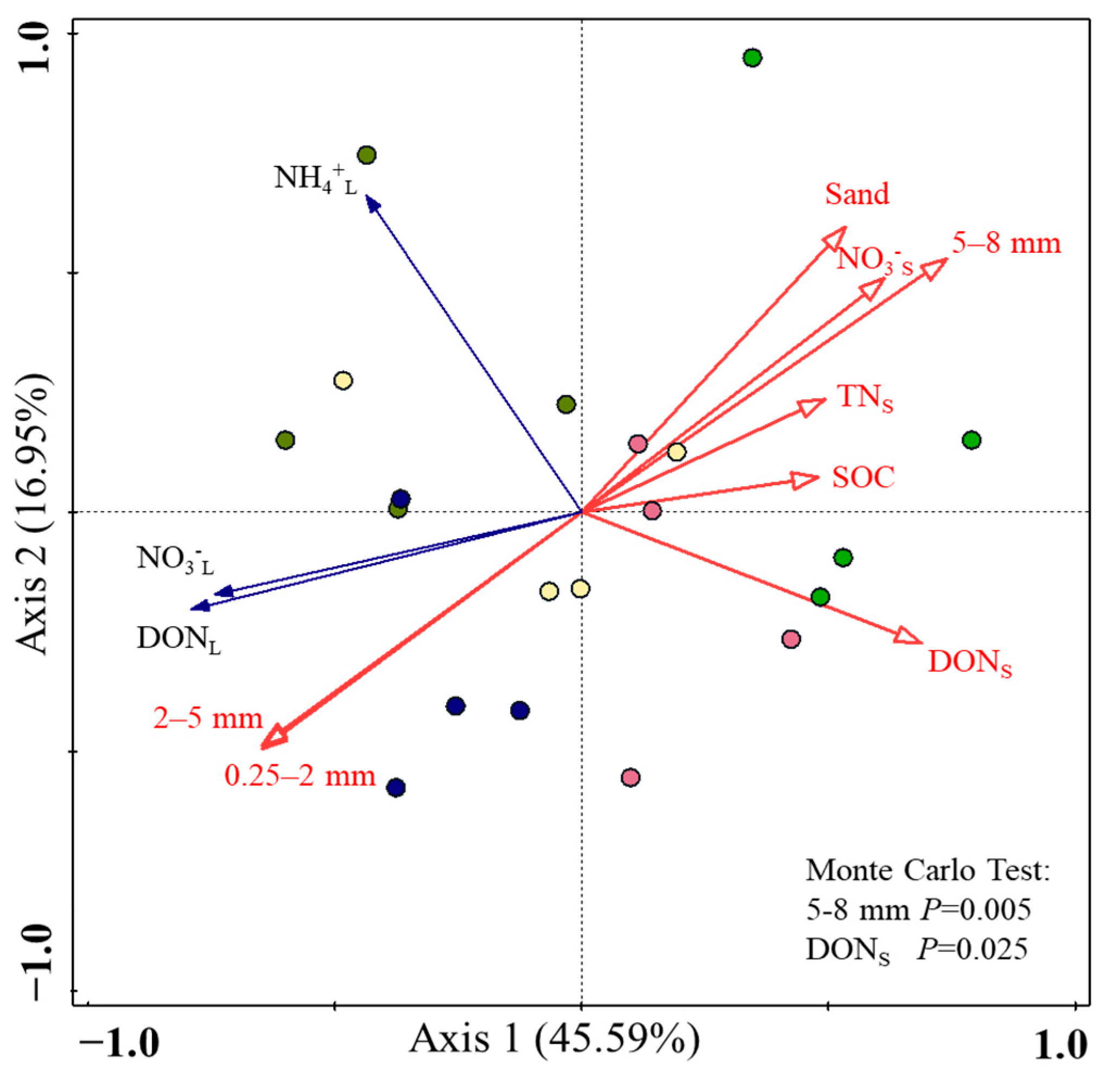Tillage-Induced Fragmentation of Large Soil Macroaggregates Increases Nitrogen Leaching in a Subtropical Karst Region
Abstract
:1. Introduction
2. Materials and Methods
2.1. Experimental Site
2.2. Experimental Design and Field Management
2.3. The Leachate Collection and Analyses
2.4. Soil Sampling and Analyses
2.5. Statistical Analyses
3. Results
3.1. Effects of Tillage Disturbance on Soil Properties
3.2. Dynamic Changes in Nitrogen Leaching under Tillage
3.3. Total Amount and Composition of Nitrogen in Leachate
3.4. Soil Aggregate Fragmentation and Other Properties Affecting N Leaching
4. Discussion
4.1. Dynamic Characteristics of Soil N Leaching
4.2. Annual Amount and Composition of Nitrogen Leaching under Tillage
4.3. Effects of Soil Properties on Nitrogen Leaching
5. Conclusions
Supplementary Materials
Author Contributions
Funding
Institutional Review Board Statement
Informed Consent Statement
Data Availability Statement
Conflicts of Interest
References
- Sun, B.; Zhang, L.; Yang, L.; Zhang, F.; Norse, D.; Zhu, Z. Agricultural non-point source pollution in China: Causes and mitigation measures. Ambio 2012, 41, 370–379. [Google Scholar] [CrossRef] [PubMed]
- Xiao, S.; Zhang, W.; Ye, Y.; Zhao, J.; Wang, K. Soil aggregate mediates the impacts of land uses on organic carbon, total nitrogen, and microbial activity in a Karst ecosystem. Sci. Rep. 2017, 7, 41402. [Google Scholar] [CrossRef]
- Gao, S.; Xu, P.; Zhou, F.; Yang, H.; Zheng, C.; Cao, W.; Tao, S.; Piao, S.; Zhao, Y.; Ji, X.; et al. Quantifying nitrogen leaching response to fertilizer additions in China’s cropland. Environ. Pollut. 2016, 211, 241–251. [Google Scholar] [CrossRef] [PubMed]
- Hess, L.J.T.; Hinckley, E.-L.S.; Robertson, G.P.; Matson, P.A. Rainfall intensification increases nitrate leaching from tilled but not no-till cropping systems in the U.S. Midwest. Agric. Ecosyst. Environ. 2020, 290, 106747. [Google Scholar] [CrossRef]
- Trolove, S.; Thomas, S.; van der Klei, G.; Beare, M.; Cichota, R.; Meenken, E. Nitrate leaching losses during pasture renewal –Effects of treading, urine, forages and tillage. Sci. Total Environ. 2019, 651, 1819–1829. [Google Scholar] [CrossRef] [PubMed]
- Guadagnin, J.C.; Bertol, I.; Cassol, P.C.; Amaral, A.J.D. Soil, water and nitrogen losses through erosion under different tillage systems. Rev. Bras. Cienc. Solo 2005, 29, 277–286. [Google Scholar] [CrossRef]
- Wang, W.; Yuan, J.; Gao, S.; Li, T.; Li, Y.; Vinay, N.; Mo, F.; Liao, Y.; Wen, X. Conservation tillage enhances crop productivity and decreases soil nitrogen losses in a rainfed agroecosystem of the Loess Plateau, China. J. Clean. Prod. 2020, 274, 122854. [Google Scholar] [CrossRef]
- Cui, S.Y.; Xue, J.F.; Chen, F.; Tang, W.G.; Zhang, H.L.; Lal, R. Tillage effects on nitrogen leaching and nitrous oxide emission from double-cropped paddy fields. Agron. J. 2014, 106, 15–23. [Google Scholar] [CrossRef]
- Montagne, D.; Cornu, S.; Le Forestier, L.; Cousin, I. Soil drainage as an active agent of recent soil evolution: A review*1 *1project supported by the Région Centre, France. Pedosphere 2009, 19, 1–13. [Google Scholar] [CrossRef]
- Wang, Q.; Wen, J.; Wen, Y.; Zhang, Y.; Zhang, N.; Wang, Y.; Bai, L.; Su, S.; Zeng, X. Alteration of soil-surface electrochemical properties by organic fertilization to reduce dissolved inorganic nitrogen leaching in paddy fields. Soil Tillage Res. 2021, 209, 104956. [Google Scholar] [CrossRef]
- Scott, E.E.; Rothstein, D.E. Patterns of DON and DOC leaching losses across a natural N Availability gradient in temperate hardwood forests. Ecosystems 2017, 20, 1250–1265. [Google Scholar] [CrossRef]
- Wang, L.; Xin, J.; Nai, H.; Zheng, X. Effects of different fertilizer applications on nitrogen leaching losses and the response in soil microbial community structure. Environ. Technol. Inov. 2021, 23, 101608. [Google Scholar] [CrossRef]
- Zhang, H.; Zhang, Y.; Yan, C.; Liu, E.; Chen, B. Soil nitrogen and its fractions between long-term conventional and no-tillage systems with straw retention in dryland farming in northern China. Geoderma 2016, 269, 138–144. [Google Scholar] [CrossRef]
- Xiao, S.S.; Ye, Y.Y.; Xiao, D.; Chen, W.R.; Zhang, W.; Wang, K.L. Effects of tillage on soil N availability, aggregate size, and microbial biomass in a subtropical karst region. Soil Tillage Res. 2019, 192, 187–195. [Google Scholar] [CrossRef]
- Gupta, V.; Germida, J.J. Soil aggregation: Influence on microbial biomass and implications for biological processes. Soil Biol. Biochem. 2015, 80, A3–A9. [Google Scholar] [CrossRef]
- Nikièma, P.; Buckley, K.E.; Enns, J.M.; Qiang, H.; Akinremi, O.O. Effects of liquid hog manure on soil available nitrogen status, nitrogen leaching losses and wheat yield on a sandy loam soil of western Canada. Can. J. Soil Sci. 2013, 93, 573–584. [Google Scholar] [CrossRef]
- Lu, J.; Bai, Z.; Velthof, G.L.; Wu, Z.; Chadwick, D.; Ma, L. Accumulation and leaching of nitrate in soils in wheat-maize production in China. Agric Water Manage. 2019, 212, 407–415. [Google Scholar] [CrossRef]
- Liu, Y.; Liu, C.; Rubinato, M.; Guo, K.; Zhou, J.; Cui, M. An assessment of soil’s nutrient deficiencies and their influence on the restoration of degraded karst vegetation in Southwest China. Forests 2020, 11, 797. [Google Scholar] [CrossRef]
- Wang, K.; Zhang, C.; Chen, H.; Yue, Y.; Zhang, W.; Zhang, M.; Qi, X.; Fu, Z. Karst landscapes of China: Patterns, ecosystem processes and services. Landscape Ecol. 2019, 34, 2743–2763. [Google Scholar] [CrossRef]
- Zhang, W.; Chen, H.; Su, Y.; Wang, K.; Lin, H.; Liu, K. Effects of reclamation and fertilization on calcareous soil fertility in the initial period of cultivation. Chin. J. Soil Sci. 2013, 44, 925–930. [Google Scholar] [CrossRef]
- Curtin, D.; Beare, M.H.; Scott, C.L.; Hernandezramirez, G.; Meenken, E.D. Mineralization of soil carbon and nitrogen following physical disturbance: A laboratory assessment. Soil Sci. Soc. Am. J. 2014, 78, 925. [Google Scholar] [CrossRef]
- Ye, Y.; Xiao, S.; Liu, S.; Zhang, W.; Zhao, J.; Chen, H.; Guggenberger, G.; Wang, K. Tillage induces rapid loss of organic carbon in large macroaggregates of calcareous soils. Soil Tillage Res. 2020, 199, 104549. [Google Scholar] [CrossRef]
- Chen, H.; Liu, J.; Wang, K.; Zhang, W. Spatial distribution of rock fragments on steep hillslopes in karst region of northwest Guangxi, China. Catena 2011, 84, 21–28. [Google Scholar] [CrossRef]
- Yang, J.; Nie, Y.; Chen, H.; Wang, S.; Wang, K. Hydraulic properties of karst fractures filled with soils and regolith materials: Implication for their ecohydrological functions. Geoderma 2016, 276, 93–101. [Google Scholar] [CrossRef]
- Sainju, U.M.; Caesar-TonThat, T.; Jabro, J.D. Carbon and nitrogen fractions in dryland soil aggregates affected by long-term tillage and cropping sequence. Soil Sci. Soc. Am. 2009, 73, 1488–1495. [Google Scholar] [CrossRef]
- Carter, M.R.; Gregorich, E.G. Soil Sampling and Methods of Analysis; CRC Press: Boca Raton, FL, USA, 2007. [Google Scholar]
- Hendershot, W.; Lalande, H.; Duquette, M. Ion exchange and exchangeable cations. Soil Sampl. Methods Anal. 1993, 19, 167–176. [Google Scholar]
- Leitner, S.; Dirnböck, T.; Kobler, J.; Zechmeister-Boltenstern, S. Legacy effects of drought on nitrate leaching in a temperate mixed forest on karst. J. Environ. Manag. 2020, 262, 110338. [Google Scholar] [CrossRef]
- Canarini, A.; Dijkstra, F.A. Dry-rewetting cycles regulate wheat carbon rhizodeposition, stabilization and nitrogen cycling. Soil. Biol. Biochem. 2015, 81, 195–203. [Google Scholar] [CrossRef]
- Smith, A.P.; Bond-Lamberty, B.; Benscoter, B.W.; Tfaily, M.M.; Hinkle, C.R.; Liu, C.; Bailey, V.L. Shifts in pore connectivity from precipitation versus groundwater rewetting increases soil carbon loss after drought. Nat. Commun. 2017, 8, 1335. [Google Scholar] [CrossRef]
- Gao, D.; Bai, E.; Li, M.; Zhao, C.; Yu, K.; Hagedorn, F. Responses of soil nitrogen and phosphorus cycling to drying and rewetting cycles: A meta-analysis. Soil. Biol. Biochem. 2020, 148, 107896. [Google Scholar] [CrossRef]
- Srivastava, R.K.; Panda, R.K.; Chakraborty, A. Quantification of nitrogen transformation and leaching response to agronomic management for maize crop under rainfed and irrigated condition. Environ. Pollut. 2020, 265, 114866. [Google Scholar] [CrossRef] [PubMed]
- Guo, Y.; Fan, R.; Zhang, X.; Zhang, Y.; Wu, D.; McLaughlin, N.; Zhang, S.; Chen, X.; Jia, S.; Liang, A. Tillage-induced effects on SOC through changes in aggregate stability and soil pore structure. Sci. Total Environ. 2020, 703, 134617. [Google Scholar] [CrossRef] [PubMed]
- Velthof, G.L.; Hoving, I.E.; Dolfing, J.; Smit, A.; Kuikman, P.J.; Oenema, O. Method and timing of grassland renovation affects herbage yield, nitrate leaching, and nitrous oxide emission in intensively managed grasslands. Nutr. Cycl. Agroecosys. 2010, 86, 401–412. [Google Scholar] [CrossRef]
- Zhang, J.; Zhu, T.; Cai, Z.; Müller, C. Nitrogen cycling in forest soils across climate gradients in Eastern China. Plant Soil 2011, 342, 419–432. [Google Scholar] [CrossRef]
- Zhu, T.; Zeng, S.; Qin, H.; Zhou, K.; Yang, H.; Lan, F.; Huang, F.; Cao, J.; Müller, C. Low nitrate retention capacity in calcareous soil under woodland in the karst region of southwestern China. Soil Biol. Biochem. 2016, 97, 99–101. [Google Scholar] [CrossRef]
- Cates, A.M.; Ruark, M.D.; Hedtcke, J.L.; Posner, J.L. Long-term tillage, rotation and perennialization effects on particulate and aggregate soil organic matter. Soil Tillage Res. 2016, 155, 371–380. [Google Scholar] [CrossRef]
- Li, H.; Gao, H.; Wu, H.; Li, W.; Wang, X.; He, J. Effects of 15 years of conservation tillage on soil structure and productivity of wheat cultivation in northern China. Soil Res. 2007, 45, 344–350. [Google Scholar] [CrossRef]
- Regelink, I.C.; Stoof, C.R.; Rousseva, S.; Weng, L.; Lair, G.J.; Kram, P.; Nikolaidis, N.P.; Kercheva, M.; Banwart, S.; Comans, R.N.J. Linkages between aggregate formation, porosity and soil chemical properties. Geoderma 2015, 247-248, 24–37. [Google Scholar] [CrossRef]
- Beaudoin, N.; Saad, J.K.; Van Laethem, C.; Machet, J.M.; Maucorps, J.; Mary, B. Nitrate leaching in intensive agriculture in Northern France: Effect of farming practices, soils and crop rotations. Agric Ecosyst. Environ. 2005, 111, 292–310. [Google Scholar] [CrossRef]
- Zhang, J.; Luo, W.; Zhang, H.; He, L.; Yang, Q.; Hu, B. Response of soil structure to different cultivation patterns in the typical karst peak-cluster depression of Northwest Guangxi. Res. Soil Water Conserv. 2019, 26, 37–42. [Google Scholar] [CrossRef]
- Shang, C.; Tiessen, H. Soil organic C sequestration and stabilization in karstic soils of Yucatan. Biogeochemistry 2003, 62, 177–196. [Google Scholar] [CrossRef]





| SOC | TN | NH4+ | NO3¯ | TDN | E-Ca | pH | Aggregate Size (%) | ||||
|---|---|---|---|---|---|---|---|---|---|---|---|
| (g kg−1) | (g kg−1) | (mg kg−1) | (mg kg−1) | (mg kg−1) | (g kg−1) | 5–8 | 2–5 | 0.25–2 | <0.25 | ||
| Mean | 37.01 | 3.17 | 31.85 | 28.01 | 77.66 | 2.97 | 6.4 | 35.38 | 43.19 | 20.24 | 1.2 |
| SE | 0.38 | 0.02 | 0.85 | 1.17 | 0.93 | 0.05 | 0.02 | 0.38 | 0.33 | 0.19 | 0.04 |
| T0 | T1 | T2 | T3 | T4 | |
|---|---|---|---|---|---|
| Aggregate 5–8 (%) | 38.84 (3.66) a | 26.40 (2.05) bc | 27.76 (2.12) b | 25.16 (0.65) bc | 20.55 (1.43) c |
| Aggregate 2–5 (%) | 36.48 (1.25) b | 43.47 (0.87) a | 42.17 (0.82) a | 41.57 (1.37) a | 43.03 (0.82) a |
| Aggregate 0.25–2 (%) | 22.00 (2.58) c | 28.23 (1.56) b | 28.75 (2.02) ab | 31.22 (0.69) ab | 34.17 (1.22) a |
| Aggregate < 0.25 (%) | 2.69 (0.29) a | 1.90 (0.17) ab | 1.74 (0.21) b | 2.05 (0.48) ab | 2.25 (0.06) ab |
| TN (g kg−1) | 3.02 (0.14) a | 2.70 (0.13) ab | 2.74 (0.15) ab | 2.57 (0.10) b | 2.50 (0.02) b |
| NO3¯ (mg kg−1) | 39.99 (3.86) a | 24.04 (3.58) bc | 28.67 (2.67) b | 16.06 (1.46) cd | 13.25 (0.82) d |
| DON (mg kg−1) | 11.90 (1.49) a | 7.31 (0.58) b | 12.08 (0.44) a | 8.02 (1.93) b | 7.42 (1.24) b |
| NH4+ (mg kg−1) | 2.45 (0.39) a | 4.52 (1.26) a | 2.91 (0.98) a | 2.59 (0.64) a | 2.77 (0.85) a |
| SOC (g kg−1) | 36.10 (2.20) a | 29.93 (2.70) ab | 30.38 (2.88) ab | 27.32 (1.71) b | 27.53 (0.88) b |
| E-Ca (g kg−1) | 2.73 (0.23) a | 2.61 (0.38) a | 2.64 (0.46) a | 2.34 (0.16) a | 2.32 (0.21) a |
| Sand (%) | 13.86 (1.27) a | 10.33 (0.98) ab | 10.17 (1.07) b | 10.10 (1.56) b | 8.86 (0.95) b |
| Soil pH | 6.51 (0.16) a | 6.46 (0.13) a | 6.39 (0.11) a | 6.43 (0.14) a | 6.44 (0.13) a |
Publisher’s Note: MDPI stays neutral with regard to jurisdictional claims in published maps and institutional affiliations. |
© 2022 by the authors. Licensee MDPI, Basel, Switzerland. This article is an open access article distributed under the terms and conditions of the Creative Commons Attribution (CC BY) license (https://creativecommons.org/licenses/by/4.0/).
Share and Cite
Xiao, S.; Liu, X.; Zhang, W.; Ye, Y.; Chen, W.; Wang, K. Tillage-Induced Fragmentation of Large Soil Macroaggregates Increases Nitrogen Leaching in a Subtropical Karst Region. Land 2022, 11, 1648. https://doi.org/10.3390/land11101648
Xiao S, Liu X, Zhang W, Ye Y, Chen W, Wang K. Tillage-Induced Fragmentation of Large Soil Macroaggregates Increases Nitrogen Leaching in a Subtropical Karst Region. Land. 2022; 11(10):1648. https://doi.org/10.3390/land11101648
Chicago/Turabian StyleXiao, Shuangshuang, Xiajiao Liu, Wei Zhang, Yingying Ye, Wurong Chen, and Kelin Wang. 2022. "Tillage-Induced Fragmentation of Large Soil Macroaggregates Increases Nitrogen Leaching in a Subtropical Karst Region" Land 11, no. 10: 1648. https://doi.org/10.3390/land11101648
APA StyleXiao, S., Liu, X., Zhang, W., Ye, Y., Chen, W., & Wang, K. (2022). Tillage-Induced Fragmentation of Large Soil Macroaggregates Increases Nitrogen Leaching in a Subtropical Karst Region. Land, 11(10), 1648. https://doi.org/10.3390/land11101648






